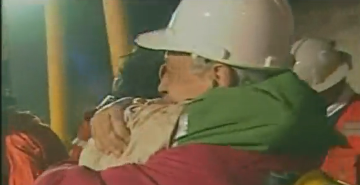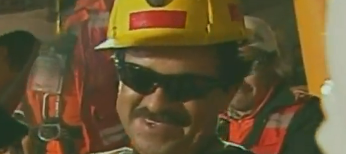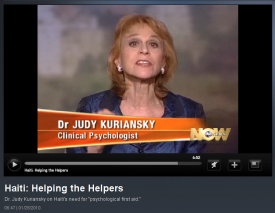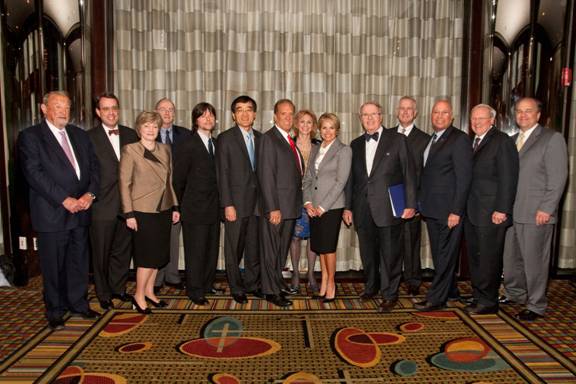“We are all addicts, the difference is your drug of choice,” television investigative journalist Jane Velez Mitchell announced to the full house at the lecture and book signing in New York City for her just-released autobiography “I Want: My journey from addiction and over-consumption to a simpler and honest life.”
The list of “stuff” we are addicted to is endless: work, gadgets, love, sugar, food, alcohol, drugs, sex, and drama.
“We are all victims of over-consumption,” Velez-Mitchell explained, including herself in the revealing public confessional about her own addictions to all that “stuff” and the inspirational account of her journey from addiction to spiritual peace and activism.
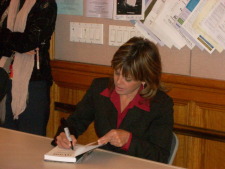 Jane signing copies of her book "I Want"
Jane signing copies of her book "I Want"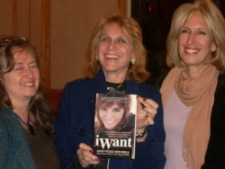 Jane's friends at her booksigning: Hilary Barsky (right) Soshonah Wolfson (left) Dr Judy (middle) who worked with her at WCBS-TV news
Jane's friends at her booksigning: Hilary Barsky (right) Soshonah Wolfson (left) Dr Judy (middle) who worked with her at WCBS-TV news
“The book wasn’t supposed to be about my life,” the veteran investigative reporter-turned talk show host and pundit, announced. “It was supposed to be about getting over addictions that millions of people have, and about how the Twelve-step program works, but as I got into it, my editor wanted me to tell my story.”
Smart editor, since every word and anecdote in Velez-Mitchell’s book is exceptionally compelling. She certainly had “Issues” – appropriately the name of her hit TV talk show airing nightly on Headline News Network. On “Issues with Jane Velez-Mitchell,” she passionately tackles tragic dramas of the day – from party mom Casey Anthony accused of killing her little girl to animal killer Michael Vick being rewarded with a TV show to Americans’ waistlines growing to deadly proportions.
“I Want” is filled with brilliant psychological truisms: “The desire to own status symbols actually reveals low self-esteem” “No material product would ever fundamentally alter my inner emotional state” and “You consciously push away what you subconsciously seek.” It’s also an exceptionally accurate description of the steps towards recovery.
The book chronicles vivid examples of Jane’s real-life experiences, from doing an early-career TV report wearing a bikini, to screaming “RRRAAAIIISSSAA” to get the attention of the then-First Lady of Russia Raisa Gorbachev, to sparring with a shopper over the use of plastic bags.
Despite her humility, Jane’s story is a tale worthy of being told, and learned from, as she goes from “insanity to clarity, egocentrism to altruism, alcoholism to activism.” It’s chick full of confessions, like that “I couldn’t go through a day without having 3 drinks.”
In true multi-addiction style, she also had “gadget lust” (buying flat screen TVs, sound systems and fancy bikes), co-dependency on love interests, and an obsession with diet soda.
On top of all that, she was “over functioning” at work (a word from the addiction vocabulary, which she lists in a helpful glossary in the back of her book), going overboard with clever tricks to “get the story” like the inside scoop on Michael Jackson’s child molestation trial, or “one-on-one” comments from Robert Redford about saving the whales or from Raisa Gorbachev about world peace.
So how did she finally kick the habits?
With true psychological insight, Jane acknowledges the multi-dimensions of the “disease,” “bottoming out” and getting sober. The one-time party-girl lush and so-called “kissing bandit” was doing “snake bites” (downing whiskey while sucking juice from a lemon in someone’s mouth), when she kissed the gay host, knocked him down the stairs and passed out. The next morning, she panicked thinking her then-boyfriend had abandoned her (the bed was empty; he was on the couch); remembered a friend bugging her to get sober; and realized that at 39 years old what she was doing was “not pretty” anymore. She called her friend, went to an Alcoholics Anonymous meeting and has been going to meetings and sober ever since. That was 14 ½ years ago.
“I called lots of people and said I was sorry for how I behaved,” she told the book signing audience at the 92 Street “Y.”
The Twelve-step meetings, and therapy, helped. “It’s a journey,” she explains, “to live a life that is kind, compassionate and of service,” with emphasis on the word “service.”
“You have to get over your ego,” she said wisely, spelling ego as “Edging God Out.”
“When you’re an addict, you play God,” she explained in her typically engaging and articulate style. “If it’s a rainy day, you say, oh, I’ll have a drink and feel better. When you surrender in the Twelve-step program, you say, ‘I’m not God.’ You get humility.”
Velez-Mitchell is a brilliant spokesperson about addiction and recovery, and even about life and love. As a psychologist, I am continually impressed with how brilliantly, eloquently and accurately she describes deeper dynamics and analyzes human behavior, evident in her book title “I Want” and her outlining of the emotional requirements for recovery: learning to sit through and deal with feelings instead of escaping them, drowning them in drink or avoiding them with other ego-based over-indulgence (bigger cars, more clothes, more “stuff”).
Addiction is genetic (her dad was an alcoholic) and also psychological. You get caught in a vicious cycle, Jane describes: (1) the “high of the buy” (if you’re a shopaholic); (2) remorse afterwards; and (3) when the remorse wears off, returning right back into the craving. The only way out: Instead of indulging the substance when you feel bad, do something else to feel better to fill the aching hole: jog, go to a move, get a massage; call a friend.
“It’s not will power, it’s a disease,” she explains.
Her talk at the “Y,” and her book, is replete with quotable, succinct “sound bites” --
the television term for clear explanations in a few short seconds. No wonder Walter Cronkite called her an “excellent reporter” when encountering her in the CBS-TV cafeteria, and why HLN host Nancy Grace (a major talk talent herself) gave her a break to express her opinion and not just the facts of cases she was covering.
Ashleigh Banfield, a fellow television journalist interviewing Jane at the book signing, told the audience that she “howled” at the story in Jane’s book when she went to Woodstock and barged into a stranger’s home to call in her story to the TV station (the farmer went to get his shotgun when he discovered her on his phone). But Jane is tough on herself, wryly calling that an incident of workaholism, and recalling her nickname “One More Bite” referring to how she would always seek one more interview or video shot to perfect a story.
After she got sober, she had “a moment of clarity” that “one more” didn’t matter. Her workaholism was even more evident to her when reflecting on how, during a vacation with a lover, she propped a camera on the pool’s edge, giving a running commentary on healthy vacationing, instead of spending intimate time with her partner.
To set boundaries, Jane advises, “You have to decide, is my work making the world a better place.” For someone like me who works a lot (though I love every minute), it was certainly issues to reflect upon.
There were also more surprising changes in store with sobriety: For example, she came out as a gay woman. Jane had publicly announced that fact a few weeks earlier in a radio talk show interview with Joey Reynolds on his syndicated WOR Radio show. She had also previously, yet hurriedly, mentioned her attraction to women years earlier on a gay man’s radio show, after feeling hypocritical discussing Idaho Republic Senator Larry Craig’s gay scandal in an airport bathroom. Her own same-sex feelings, she describes in her book, date back to high school. Fearing those inklings at that time, she was purposefully rude to women she secretly coveted.
“I’m so happy I got sober, I got happy and I came out as a gay woman,” she told the “Y” audience.
The lessons of “I Want” and Jane’s journey are not only psychologically valid, but also spiritually enlightened, not unlike a modern-day version of a classic book Jane (and many youth) read in high school, Herman Hesse’s Siddhartha. Jane likens the Twelve Steps’ principles to the Buddhist Noble Eightfold Path: right thoughts, right conduct, right livelihood and right effort – about practicing nonviolence, compassion and kindness. Seek moderation rather than craving which only leads to suffering.
With a knack to get the facts (always responsibly warning her outspoken guests on her TV talk show not to indict a subject they’re analyzing before proven guilty), Jane also has uncanny psychological insight and ability to clearly outline dynamics. It’s a quality as a psychologist I find tremendously impressive (and for which I give her an “honorary psychology degree”). When interviewing me about the cases in her book “Secrets can be Murder: What America’s Most Sensational Crimes Tell Us About Ourselves,” she brilliantly analyzed the cases; for example, tracing the demons of multi-millionaire record producer-and- convicted killer Phil Spector back to his father’s suicide, and analyzing his proclivity for shoving guns into women’s mouths as signs of phallic aggression.
Jane has equal insight into her own dynamics, weaving captivating stories about herself and even reflecting on her childhood lessons, like (1) don’t be boring; and (2) always DO something (never just sit there doing nothing, like mindlessly watching TV); and (3) express yourself in an interesting way. She certainly does that, as a great story- teller.
Her upbringing, Jane reveals, was “eccentric.” Her Irish Catholic father (to whom she dedicates her book), a suave, debonair and successful advertising executive was sadly also an alcoholic, who died too soon. And her now 93-year old “flamboyant” Puerto Rican dancer and performer mom, sent her to endless classes – on elocution, tap, and Hindi dance. Both had major influences on her life and traits. Her mom, sitting proudly in the audience, was always ahead of the curve, Jane described, teaching her (when she was only 6-years old) about veganism by serving guests vegan food, long before that lifestyle became well-known.
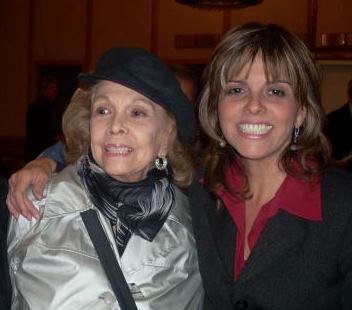 Jane with her 93 year old mom AnitaJane grew up to become a major animal activist, along with friends like Peter Max (who is throwing her a book party), the head of PETA, and her first female long-time love, Sandra, with whom she made animal rights documentaries.
Jane with her 93 year old mom AnitaJane grew up to become a major animal activist, along with friends like Peter Max (who is throwing her a book party), the head of PETA, and her first female long-time love, Sandra, with whom she made animal rights documentaries.
“There are more than 100 vegan restaurants in New York City,” Jane announces, explaining that it’s not impossible to be vegan and also live a full social life. It’s also a peaceful life.
“Peace is on your plate,” says Jane, referring to the PETA slogan that eating animal products amounts to killing. “No matter what happens today,” Jane explains as her philosophy of life, “I am happy because I went through the day without killing something.”
In another take-away vignette – so typical of the conciseness and vividness with which she speaks – Jane explained that eating meat is the single cause of world hunger because the amount of grain that it takes to feed animals could feed the world’s poor. “We’re hogging our resources,” she declared.
Jane’s commitment to peace was evident to me when I was in Amman, Jordan at a conference, and she called me (at 4 am Middle East time), to be a guest on the radio talk show she was fill-in host for. She wanted to talk about the lobbing in Washington D.C. I had just done with the Peace Alliance for a Cabinet level Department of Peace, spearheaded by Ohio Republic representative Dennis Kucinich. Always on the cutting edge of issues, Jane had long been talking publicly about this issue: “We have a department of war, called the Defense Department,” I have heard her say, “So why can’t we have a Department of Peace.”
Good friends figure largely in Jane’s current happy life, as does her love for her three Chihuahua mixes. That Jane has a heart of gold is evident in the fact that she recently adopted an elderly dog to add to her brood of two cherished younger ones.
Going to AA meetings also helps.
"Why do 12-step meetings work?” an audience member asked.
Telling your story to others helps you realize you’re not alone, that your experience is not shame-based, and that others support you, Jane explained. The reasons resonated with me, as they were the same reasons my radio call-in advice show listeners were so avid, feeling comforted knowing they are not alone, not the only one with their problem, and that help and support is available.
Seeming motivated by talk of the value of such sharing, Banfield surprised the audience saying, “I was 190 pounds two years ago. I struggle with it everyday.” Now, she explained, she has two children and no time for over-indulging.
Banfield, a gifted story-teller like Velez-Mitchell, also resonated with Jane’s commitment to protect the environment, evident in her carrying groceries in a cloth bag to avoid using plastic. Tiny pieces of plastic get carried in the ocean, she explained, eaten by fish and then passed on to humans. Frightening.
The take-aways included the vivid stories and lessons learned. Through her journey, Jane learned to distinguish between “want’ and “need,” and reached “psychological relief” from the pressure to succeed and control. Even her breast cancer scare, and subsequent surgery and radiation, was a “wake-up” call to get in touch with her feelings and to change: to decrease materialism and increase efforts to make a difference.
The passionate personality now surprises herself that she prays. “I wake up every morning and ask, ‘Please higher power, help me to humbly be of service, and make my day not just about what’s in it for me’,” she says.
After her talk, as fans lined up to get a copy of her book signed, some could be heard commenting, “She has so much courage to go public with what she’s gone through.”
Jane had earlier addressed that issue. “I don’t care anymore about how people judge me,” she had said. “It’s part of my spiritual growth. As an alcoholic you judge all the time- yourself and others – now that I am sober, I don’t judge myself or others anymore. I accept myself, and I am no longer ashamed of me.”
Her ultimate, ever-so-smart mantra at the end of her book marking the continuation of her journey: I do enough, I am enough, and I have enough.”
 Thursday, October 14, 2010 at 10:57PM
Thursday, October 14, 2010 at 10:57PM 